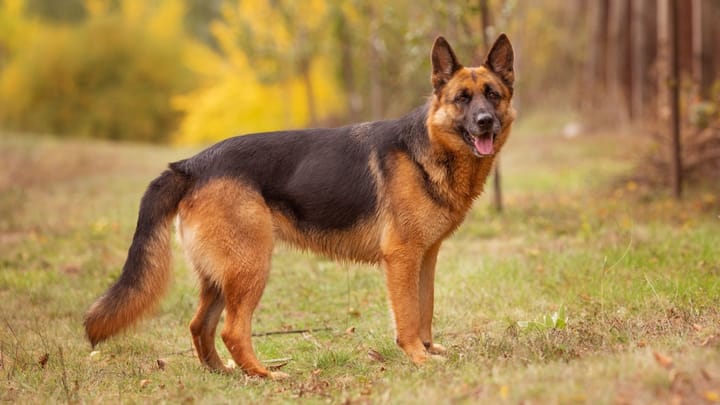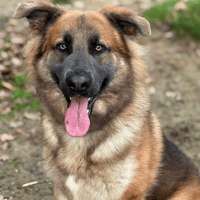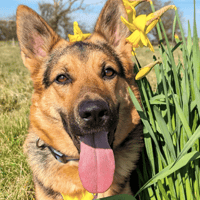German Shepherd
Other name: Alsatian


German Shepherds have many qualities that make them fantastic working dogs as well as family dogs. Also known as Alsatians, German Shepherds have been used as guide dogs for the blind, police dogs, and even herding dogs. Their high intelligence and versatility have made them one of the most popular dog breeds in the world, earning them a consistently high spot in the UK’s most popular dog breeds rankings for decades.
|
Life expectancy |
The German Shepherd has a life expectancy of between 10 and 13 years |
|
Temperament |
|
|
Size |
Medium
|
|
Adult size |
Female
Between 22 and 24 in
Male
Between 24 and 26 in
|
|
Adult weight |
Female
Between 49 and 71 lb
Male
Between 66 and 88 lb
|
|
Coat colour
His coat can be a black or grey unicolour, black with tan markings, brown or yellow, and sometimes light grey. White does not fall under the breed’s official standards. |
Black Brown Blue Red |
|
Type of coat
There are two varieties: short-haired or medium-long to long-haired. His coat is double-layered, consisting of an outer coat and undercoat. For the short-haired breed, his outer coat is dense, straight, soft to the touch and very thick. His undercoat is also thick. As for his long-haired counterparts, his outer coat is smooth, loose and consists of layers. His undercoat is thick. |
Short Long |
|
Eye colour
His eyes should always be very dark. Light eyes do not adhere to the official standards of the breed. |
Brown
|
|
Purchase price |
The German Shepherd costs between £620 and £900 |
The German Shepherd family has grown over the years due to the recognition of the breed’s official standards of traits previously considered as flaws. Here are two concrete examples:
The White Swiss Shepherd that was initially a German Shepherd with a white coat. This trait was considered a flaw until 2003, when this breed was officially recognised by the FCI.
The long-haired German Shepherd was also excluded from the breed’s official standards for a number of years. Only in 2011 did the FCI officially recognise this long-haired dog, which was necessary for the breed to participate in competitions and other canine exhibitions.
More details about the German Shepherd
German Shepherd: Origins and history
At the end of the 19th century in Germany, when industrialisation was bringing sheep farming to an end, a group of dog lovers decided to come to the rescue of sheepdogs, a precious genetic heritage: they used them to create a multi-talented, beautiful, eclectic and docile dog who was easy to breed and train. It was only upon the cross-breeding of the Württemberg and Thuringe sheepdogs that these dog enthusiasts got this new breed which, thanks to colonel Von Stephanitz and his canine passion, quickly became one of the most loved and widespread dogs in the world. The German Shepherd was officially recognised in 1898.
Physical characteristics of the German Shepherd
Also known as the Alsatian, this medium-sized dog is slightly longer than he is tall. He is strong, has a well-proportioned stature and is lean and solid. His back bows in the middle, which is a classic trait of this breed.
FCI classification of the German Shepherd
-
Group 1 - Sheepdogs and Cattledogs (except Swiss Cattledogs)
-
Section 1 : Sheepdogs
German Shepherd: Characteristics
German Shepherd: Behaviour
Training a German Shepherd
Equipped with a remarkable intelligence and attention span, educating this dog won’t be a challenge, as long as his training methods are respectful of the principles of positive education.
Patience, gentleness and determination will be the keys to the results you want with this strong-willed dog.
Training must start early so as not to wait until he has reached his adult size and weight.
German Shepherd: Lifestyle
Breed compatibility German Shepherd
German Shepherd: Purchase price
The price of a German Shepherd varies according to his origins, coat, age and sex. You should budget around £620 to £900 for a dog registered with the KC.
You should set aside around £55 a month to provide your dog with a high-quality diet and respond to his basic needs (vaccinations, deworming, anti-parasites).
German Shepherd: Shedding
Heavy !
The German Shepherd’s hair loss is constant, especially for dogs living predominantly inside. In spring and autumn, his significant shedding will require an almost daily brush to get rid of excess hair.
German Shepherd: Grooming
The grooming of a German Shepherd isn’t difficult, but it should be regular, especially for long-haired types.
He should be brushed on a weekly basis to keep his coat shiny and protective.
However, be aware that grooming that is too frequent (especially baths) can actually weaken his weather-resistant coat.
It’s necessary to pay particular attention to this dog’s ears: they should be cleaned regularly to avoid infection.
His claws should also be regularly clipped, as they can grow very quickly.
German Shepherd: Health
The German Shepherd can live up to 13 years.
The German Shepherd is often considered as a sensitive dog, but as long as he was properly bred, he will be very resilient.
His popularity is such that he is studied much more closely than most other dogs. As a result, he is subjected to a number of pathologies that are common in medium and large dogs, such as dysplasia.
The heat doesn’t scare off this dog, nor does it prevent him in excelling in his many different disciplines.
His double-layered coat gives him good protection against adverse weather conditions. He isn’t put off by the cold or humidity.
His greediness would have the potential to get the better of him if it wasn’t for his incredibly active nature.
However, you should pay close attention to German Shepherds who engage in less exercise than they should.
- Hip dysplasia (despite the efforts of breeders)
- Expansion/twisting of the stomach
- Hypothyroidism
- Von Willebrand disease (hereditary hemorrhagic disorder)
- Degenerative myelopathy (genetic disorder leading to complete paralysis of the animal)
- Pancreatitis
- Anal fistulas (disorder of the immune system)
- Epilepsy (Disorder of the nervous system)
- Hemangiosarcoma (aggressive cancerous tumour)
- Osteosarcoma (tumour of the bones)










